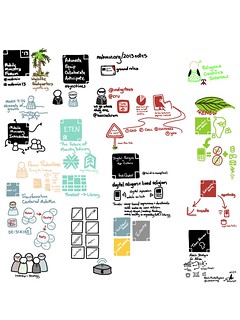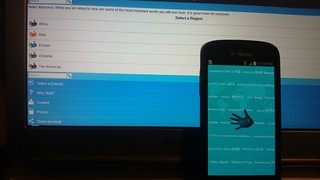Welcome to the second issue of Mobile Ministry Magazine (MMM) simply titled Envisioning. There was a decent response from the year’s first issue and so we are going to continue down the same path with this package of observations and insights from the mobile ministry (#mobmin) space.
Tag Archives: mobile in personal
2014 Issue 1: Making It Simple
Welcome to a refreshed Mobile Ministry Magazine (MMM). Starting this year, we are going back to the simplicity of the issue format. Each month we will be hitting on those points where you can discover, observe, relate, or be released into mobile ministry (#mobmin) efforts. It’s a packed issue, let’s get into it.
A Few in the Tabs
I’ve got a few pieces sitting in the tabs that I’ve wanted to expound on, but just haven’t made the time to do so. Here are some of those items sitting under that extended contemplation:
…One of the things I love most about technology is the space it allows us to dream and innovate. There’s always an opportunity for something new and people are hungry for it. So, if mobile technology has truly expanded to become a part of our daily life, how can we use this to reach people with the truth of Jesus Christ?
Read the rest of Mobile Technology and the Church at The Issachar Initiative
…Second, I’d like to point you to a great little book called Shaping a Digital World: Faith, Culture and Computer Technology by Derek Shuurman, a computer science professor at Redeemer University College in Canada…
Read the rest of TheoMedia and Other Great, New Books on Technology at Don’t Eat the Fruit
…Vision must be aligned to the company’s mission: What is great about the drones is that they actually make a lot of sense given Amazon’s core business model. As I wrote previously in Amazon’s Dominant Strategy…
Read the rest of Amazon and the Benefits of Vision at Stratechery
…this points to how important research triangulation is to make good decisions based on insights, not just data. Real insights are found at the intersection of different research methods. Not over in the corner with just one method…
Read the rest of Conversions Are Not People at Elezea
In the case of the touchscreen, the spatial and visual meaning is not exactly gone, but is now floating and inflated. The touchscreen has multiple screens—each screen, a unique landscape. The single smooth surface offers itself for multiple landscapes and constantly changing meanings. At one moment, a swipe will unlock the phone; the next, the same swipe will answer an incoming call. Same motion, same locations, different meanings. The touchscreen’s agnosticism permits multiplied meanings.
Read the rest of Unbuttoned: The Meaning of Buttons in a Touchscreen World at The Second Eclectic
…Digicel built its business model around going to small, difficult countries that larger companies would avoid. These countries are challenging environments that “you’d run a mile from” because they don’t seem to have the resources to afford mobile telephony, says Colm Delves, Digicel’s CEO…
These all might read like stars on a cloudy night. But, I’ve had them set because these all speak to various points about mobile ministry which might elevate opportunity, best practice, caution, or surprise. I don’t know what might consist of those items on your reading list, but these are just a few of mine. As you walk though the holiday – and a slower news cycle – perhaps part of what stays open in your tabs provokes your imagination or sense of opportunity.
Does Mobile Finish the Task
Through the recent MMF Consultation, we connected with the group Christ for All Peoples. They are one of very few organizations whose missional impact takes the perspective of reaching out to immigrants, and letting that influence put them in the position to go to various people groups around the world. During our time chatting, one of the pieces of information shared came from the website Finishing the Task which not only impressed the state of the missions movement, but also begs the questions if/when/how mobile can help finish the task.
Unreached People Groups (PDF) from Finishing the Task
Some years ago, we talked about realistically looking at the impacts of mobile. I think this dataset allows for us to revisit that question, and then ask of our methods and activities if we are engaging the technology and behaviors of mobile correctly in order to finish the task. As we stated on the panel at the MMF Consultation – information is not transformation. We cannot make a mountain out of distribution methods, and do nothing about lifestyle. We cannot just put a bible on a device and expect that literacy rates will rise and with that people will engage Christ. There’s something a bit more… detailed about the point of using mobile that our methods in mobile ministry have to speak towards. And when they do, then we see without a doubt that mobile ministry is truly effective.
So, for your organization, what about mobile directly or indirectly finishes the task of getting the Gospel to the ends of the earth?
Mobile, Privacy, and Considerations
Its easy to continue down the consumer line that the holiday brings – talking new devices, apps, and services, and leaving weighter concerns to the opt-ed pieces which might hit a magazine or two. And then there’s that sense of responsibility. A condition of mobile in ministry is to understand the landscape and the challenges of just being in this space. In light of what we do, own, or promote, it our responsibility to pay attention to what might negate this landscape as well.
…Thanks to smartphones or Google Glass, we can now be pinged whenever we are about to do something stupid, unhealthy, or unsound. We wouldn’t necessarily need to know why the action would be wrong: the system’s algorithms do the moral calculus on their own. Citizens take on the role of information machines that feed the techno-bureaucratic complex with our data. And why wouldn’t we, if we are promised slimmer waistlines, cleaner air, or longer (and safer) lives in return?
This logic of preëmption is not different from that of the NSA in its fight against terror: let’s prevent problems rather than deal with their consequences. Even if we tie the hands of the NSA—by some combination of better oversight, stricter rules on data access, or stronger and friendlier encryption technologies—the data hunger of other state institutions would remain. They will justify it. On issues like obesity or climate change—where the policy makers are quick to add that we are facing a ticking-bomb scenario—they will say a little deficit of democracy can go a long way…
That segment is from an article that’s stayed open in a tab for me for a number of weeks now. The Real Privacy Problem at MIT Technology Review is a must-read, must-bookmark, and must share.
And yet, that’s not the end of things. We understand that its not just what we do which is being exposed, but what others are gathering about our actions which present very real challenges – if not outright defining characteristics – to what it means to have mobile ministry practices.
…The NSA has no reason to suspect that the movements of the overwhelming majority of cellphone users would be relevant to national security. Rather, it collects locations in bulk because its most powerful analytic tools — known collectively as CO-TRAVELER — allow it to look for unknown associates of known intelligence targets by tracking people whose movements intersect.
Still, location data, especially when aggregated over time, are widely regarded among privacy advocates as uniquely sensitive. Sophisticated mathematical techniques enable NSA analysts to map cellphone owners’ relationships by correlating their patterns of movement over time with thousands or millions of other phone users who cross their paths. Cellphones broadcast their locations even when they are not being used to place a call or send a text message…
The Washington Post and others have been very brazen in publishing items like this. Whether or not one can get around that kind of monitoring is one thing, understanding what that monitoring means is another. And the truth also exposed here has to be understood – if countries are advanced enough to pursue these complicated and powerful means of using data to make connections, countries/governments/organizations/individuals which don’t have that skill, or have the controls in place that might be present legally/ethically here, not only have that ability, but have been working in similar manners.
Don’t just be so naive to dismiss the dangers when running towards the opportunities.
Don’t be so paralyzed by the dangers that you neglect running towards the opportunities.
The Bible App for Kids
Was really good to see this earlier in November that it was coming, and now its here. YouVersion has released The Bible App for Kids – an animated and achievement-oriented Bible application for Apple iOS, Android, and Kindle Fire devices.
It something that I’ve already given a headsup to my God children and niece. Will be neat to see how/if The Bible App for Kids morphs into other languages and cultures – not only speaking the Word in a language kids can hear, but also offering kids an opportunity to see how other kids look and interact with the Bible.
Visit The Bible App for Kids website to learn more and download.
Advent
Once again, the Church has entered into the Advent season. Many of us take this time to not just prepare for the holiday but to reflect towards how the entrance of Jesus into our own lives has upset the norm and changed things.
If a mobile app helps you get to that point of reflection, this small listing is here for you (found a ton more for Android here). If the traditional Advent calendar is more your speed, there are several for sale still – with candle holders and other peek-a-boo doors – for example, this one for Outlook and similar apps.
May you take the time to reflect on the soon-coming Messiah, and draw your strength in grace of his birth.
CLA Mobile Ministry Course Registration Open
The Christian Leadership Alliance (CLA) has again opened the door to their winter session and the course we designed and will facilitate – Creating a Mobile Ministry: Mobile Ministry Introduction and Relevance – is going to be offered.
Learning Objectives
This course is designed to provide participants a better understanding of mobile technologies used in ministry practices. Upon completion, the participant should have a better understanding of the current information that is known in this space, be able to ask/answer questions of that information, and then generate new questions that will lead to sound research and applications of mobile technologies in ministry applications.
Module Overview
This course intends to lead the participant into an understanding of mobile technologies and behaviors which influence faith practices within Christian and other religious spaces, with the goal of creating a theological and sociological framework for analyzing, discussing, and leading local/global communities in mobile interactions. The participant will have the knowledge and foundational skills to supplement existing ministry activities, or start new ones which utilize mobile technologies, communications, and/or behaviors.
You can register for Creating a Mobile Ministry: Mobile Ministry Introduction and Relevance at the CLA website.
As with the previous offerings, if you have specific questions which are not answered on the course website, do ask.
iPrayer
As you might have noticed in that post about the sidebar additions, we’ve featured a few mobile apps which are outliers in the mobile ministry space. Not so much because they are popular, but because they do things which are uniquely mobile, uniquely faith-first, and generally, meeting a niche need square on. iPrayer kneels squarely on those points.

This really isn’t a review of iPrayer as much as its an appreciation of what it does well. Much like the 1st version of Instagram, its a mobile-first social network. Once its installed, you don’t need an account to get into it, but it does help if you plan on posting prayers and interacting with the iPrayer community.
Much like MMM, there’s only one person behind the scenes at iPrayer, and that shows in the Daily Word feature. I like that idea, though in speaking with the developer, he mentioned that its possible that iPrayer could configured differently to allow for others’s to be profiled in the Daily Word.
I’ll say though that the thing which really opened my eyes to iPrayer was the UI (user interface). When I looked at the landing screen, my first thought was multi-lingual support. There were so few words and the icon design was so clear that I instantly thought about this being a mobile community app able to serve several languages at the same time. In that convo with the developer, there were no plans to go towards other languages. But, there are other language communities present. Seriously, neat.
My iPad now gets notifications from iPrayer when new devotionals are published. Like another app we’ve reviewed – Bible Bloom – its not about an intense study, but intentional contemplation about those things God desires from us. iPrayer was designed for those folks who have a need for prayer, but might not be as connected locally as some would wish. Its a neat app/service, and one we are proud to push forward as iPrayer is developed further.
Why Hasn’t Digital Publishing Caught Up

Was pointed to this via Google+ the other day. But to be frank, its the same discussion, just revisited – with another proposal from someone well associated with digital publishing technologically and organizationally.
In August 2010 we posted an article entitled Tired of Buying the Same Books Over and Over Again. In that post, Kevin Purcell proposed an idea that would allow for bible software customers to buy a digital resource once and then make it available via other Bible software at no additional cost. From a ministry perspective the plan was a good idea. Here we are three years later and the situation remains the same. We still must buy multiple copies of books to use in various programs.
Read the rest of The Next Step at Kevin Purcell’s website
Kevin then writes his response in STEP Backwards: A Counterpoint to The Next Step
Here’s where I get frustrated. Since the digital copies made, after copy one, cost nothing. I have a problem with the second Bible software company selling customers a commentary that they already bought for $9,000 from Awesome Bible Software for the same price. If the customer can prove that they own the book, the publisher should wave the royalty fee and the Christians at the second company should sell the book in their software format at a reduced rate to cover costs of the sale and a little extra. It’s in their best interests to do this because the customer will become a return customer if they can use their favorite books in the second software maker’s program. If they can’t they won’t buy more in the future.
Now personally, I think that to solve this issue of using biblical resources across several devices and applications that there needs to be a significant change of thought and practice. Contrary to the marketing messages, bible software is built for pastors, not laypersons; content licenses are built for publishers, not readers. To design and sell software differently is a challenge that some groups can embrace. It won’t be easy, yet it could be very fruitful.
Jump into the discussion at Kevin’s website, here, or via social media.





